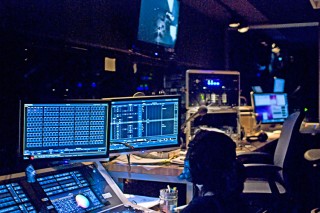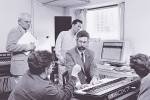Column Name
Title
Subhead

The Music Technology Center in 2010.
(Photo by Jill Steinberg)For this special technology issue, The Journal went behind the scenes at the Center for Innovation in the Arts.
Body
On Juilliard’s third floor, a small, technology-enlightened department is working to change the course of the entire school. By training conservatory students in the ever-growing toolkit of sonic and visual technology, Juilliard’s Center for Innovation in the Arts (formerly the Music Technology Center) is nurturing the artists of the future.
While Juilliard can’t anticipate students’ every need, the center does offer a full audiovisual suite and recording studio, custom-designed digital performance controllers, and a software library that allows for the interaction of living, breathing performers with electronic accompaniment. The Meredith Willson Theater just down the hall was designed to be integrated with these technologies, including projection and lighting rigs, surround sound, and other digital infrastructure that provides a space for students, faculty, and outside artists alike to bring their projects to an audience.
The main way those projects get to an audience is the Beyond the Machine festival, a public forum for tech-infused interdisciplinary works. Recent projects have included linking three piano players on three continents for a live performance, and creating software and hardware elements to accompany the players as “digital co-performers,” which are controlled with highly sensitive electronic instruments. An adaptation of Terry Riley’s In C is scheduled for the next festival, which takes place in late March. In it, 53 short, interchangeable dance sequences (or visual “phrases”) were filmed to correspond with 53 musical units from Riley’s composition. These will be displayed and processed on multiple screens as the piece is performed, allowing for an integrated, improvisatory performance that would not have been possible without the sophisticated triggering, synchronizing, and controlling hardware and software devised at the center.
Willie Fastenow, technical director for both the center and the festival, says the annual performance series also provides a way to realize their students’ ideas with greater resources than what’s available in the classes the center offers. “Some of what exists for or with B.T.M. isn’t stuff we have classes rooted in yet,” he says. “We’re trying to get there—we’re growing, and we have lots of great ideas for new classes.”
One of the major challenges faced in trying to get more students involved is the creative culture at the center, which is quite different from the classics-oriented mindset of traditional conservatory coursework. “The kind of work we do here in some ways represents the exact opposite end of the experience conservatory students are accustomed to,” faculty member Edward Bilous (M.M. ’80, D.M.A. ’84, composition), the director of the center, told The Journal recently. “There are no boundaries, no historical lenses or filters; we’re not influenced by how this would have been done in the 18th century. What we think about is, how do you connect to the society that you live in? And how are you, as a creative being, going to reflect what’s going on in the larger world around you?”
The Music Technology Center was formed out of the old Electronic Music Center two decades ago in part to allow Juilliard to “take a “proactive step in confronting the sticky relationship between music and technology,” The Journal reported at the time. President Joseph W. Polisi asked Bilous, then on the Literature and Materials of Music faculty, to run it, which he’s done ever since. “The writing was on the wall 20 and 30 years ago, but now I think it’s absolutely core,” Bilous says. “Young composers now feel very comfortable working in a range of genres—they’ll write an opera, do a film score or a ballet; they’ll write a theme for a television show or produce a rock record—it is absolutely commonplace now for a composer to move with total ease and comfort between those various worlds.”
The center’s name was changed in 2012 in part to reflect a broader focus. “Increasingly, students in drama and dance want to use new technology and do interdisciplinary works,” Bilous says. He hopes to set up a summer program that would allow dance, drama, and music students to develop projects together before performing them during the academic year.
Raising issues of technology in a conservatory setting is not without its challenges. For students and teachers who are living and breathing classic repertoire on traditional instruments, delving into software like Logic Pro or Max MSP may seem superfluous. But Bilous points out that technology is as fundamental to the modern artist as a paintbrush was to Rembrandt, noting, “Something like 98 percent of all music listened to in the world today is done through a set of speakers. People experience music as an electronic event, and if you don’t have those tools as a creative artist, then you’re limited to speaking only to the other 2 percent of music lovers out there.”
Juilliard’s technology courses often only have about six students and can therefore be tailored to the interests of the participants while providing an overall curriculum that covers the basics no matter which discipline a student comes from. “We’re trying to design the classes with a path in mind, so people who don’t really have previous experience could do Intro to Music Technology and start to learn the vocabulary and the tools,” Fastenow says. “Then, if they want to continue with that they could pick a path to go further into.” The hope is to add basic videography and projection design classes to the roster.
One of the challenges the center faces in attracting more students is logistical. Recent alum and current Evening Division faculty member Emi Ferguson (M.M. ’11, Historical Performance; B.M. ’09, M.M. ’12, flute) started taking music technology courses during her final year at Juilliard but would have liked to have gotten started sooner if she’d had time in her schedule. “All of these are things I could have used as a freshman, as a sophomore,” she told The Journal recently. “I wish that I had been able to do it then.”
In the November Beyond the Machine festival, she performed a piece by Russell Pinkston titled Lizamander in which she played with computerized accompaniment that proceeded according to Ferguson’s actions on stage, rather than moving through a predetermined sequence of events. She has continued working with responsive technology because it allows her to enhance a performance without sacrificing expression. “It’s organic to move and flow depending on the space, the people, or your mood the same way you would with any other piece of music. To be able to have the technology move along with you is huge.”





